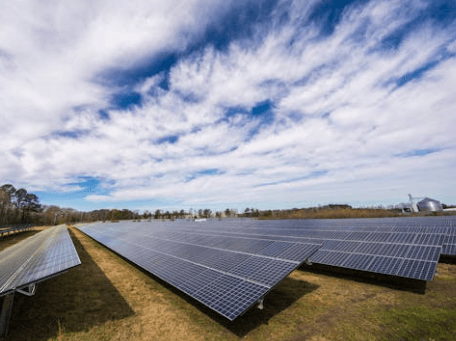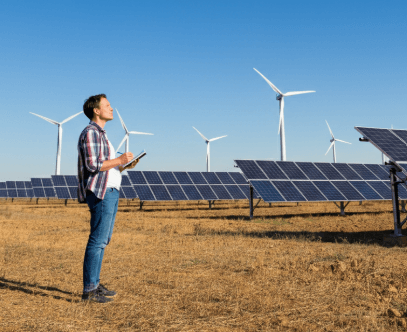Solar and wind farms are changing how we use land to meet the increasing demand for energy, creating a path toward a more sustainable future. Studies show the U.S. energy system currently consumes 74.5 million acres of land, with wind and solar using less than 1% of that footprint while providing 13.1% of the nation’s electricity. If you’re considering buying land for renewable energy projects, understanding the best options, benefits, and strategies is crucial. Experts like Steve Daria and Joleigh, renowned real estate investors and cash land buyers, can simplify the process with their proven expertise. Whether you aim to develop wind turbines on agricultural land or explore solar panel installations, knowing the land requirements and opportunities is key to success. Buying land for renewable energy projects can be a financially and environmentally rewarding choice. Connect with Steve Daria and Joleigh today to book a free discussion and unlock expert guidance for your renewable energy investment!
What is renewable energy land use?
Renewable energy land use refers to the amount and type of land required for projects such as solar farms and wind turbines.
For example, wind farms are often placed in large, open spaces, but the land between turbines can still be used for activities such as farming.
Similarly, solar farms require open land for installing panels, though some innovative setups allow for dual use with agriculture.

These projects strike a balance between the need for clean energy and efficient land use, thereby minimizing their impact on local ecosystems.
When buying land for renewable energy projects, it’s important to consider factors like sunlight, wind potential, and the proximity to power grids.
Proper planning ensures the land is both environmentally suitable and economically viable for generating energy.
Shifting to renewable energy not only helps reduce carbon emissions but also unlocks innovative and sustainable ways to repurpose land.
Thoughtful use of land makes renewable energy a win for both the environment and the economy.
Get Started: Get Your Cash Offer Below…
We are direct land buyers. There are no commissions or fees and no obligation whatsoever. Start below by sharing where your property is and where we can send your offer…
How does solar energy impact land use?
Solar energy requires large open spaces for panels to convert sunlight into sustainable electricity.
Large-scale solar farms can occupy a significant amount of land, often in rural or desert regions where sunlight is abundant.
However, solar projects can also be designed to coexist with other land uses, like agriculture, through innovations like agrivoltaics, which combine solar panels with crop production.
Beyond open land, solar panels can be installed on rooftops or unused urban spaces, making land use more efficient.
When buying land for renewable energy projects, it’s important to assess factors like soil type, sunlight exposure, and proximity to infrastructure that connects to the energy grid.
Thoughtful planning can ensure that solar energy projects use land efficiently while minimizing environmental impacts.
By leveraging underutilized spaces and incorporating sustainability, solar energy enhances land use without displacing other activities.
Its adaptability makes it a key player in transitioning to cleaner energy sources.
What factors should I consider before buying land for renewable energy projects?
- Sunlight and Wind Resources: Assess whether the land receives enough sunlight or has consistent wind patterns to support solar or wind energy projects. Tools like solar maps or wind resource data can help estimate the site’s energy potential.
- Zoning and Land Use Regulations: Check local zoning laws to ensure the land can legally be used for renewable energy purposes. Some areas may have restrictions or specific requirements for energy projects, like environmental impact assessments.
- Proximity to Energy Infrastructure: Assess the distance between the land and power grids or substations, as this impacts the cost and feasibility of transmitting the generated energy. Easier access to infrastructure can reduce both setup time and expenses.
- Environmental and Soil Conditions: Examine the landscape to identify any environmental issues, such as protected habitats, flood zones, or unstable soil. A thorough inspection ensures that building energy systems won’t lead to unexpected challenges later.
- Land Size and Shape: Consider the size and shape of the plot to confirm it meets the space needs of your renewable energy project. Large, open, or flat areas are often preferred for efficient installations of systems like solar panels or wind turbines.

What permissions are required for renewable energy projects?
Renewable energy projects typically require several permissions to ensure they are built legally and responsibly.
First, zoning approval is required to ensure the land is permitted for solar or wind energy use.
Next, building permits are required to make sure the construction meets safety standards and regulations.
Environmental clearances may also be necessary to verify that the project won’t harm local ecosystems or wildlife.
When buying land for renewable energy projects, it’s important to check if the land is subject to any restrictions or protected area designations.
You might also need a grid connection agreement to link the project to the power grid.
Often, developers must submit detailed plans and studies for approval from local or state authorities.
Additionally, if the land is leased, you’ll likely need permission from the owner for specific changes.
Ensuring all permissions are in place is crucial not only for legal compliance but also for the smooth execution of the project.
What financing options are available for buying land for renewable energy projects?
1. Bank Loans
Traditional bank loans remain a popular and reliable option for financing land acquisitions for renewable energy projects.
Banks offer loans based on your creditworthiness and the potential value of the project.
This option allows you to spread the cost over several years while starting your renewable energy development.
2. Government Grants and Subsidies
Many governments provide grants or subsidies to support renewable energy projects.
These initiatives help lower the initial costs of acquiring land for renewable energy projects, making sustainable development more accessible and affordable.
It’s essential to research the available programs in your region to determine if you qualify and to learn about the application process.
3. Investor Partnerships
Partnering with investors is another way to secure funds for renewable energy land purchases.
Investors contribute capital in return for a share of the project’s profits.
This option not only makes buying land for renewable energy projects affordable but also brings in expertise and support for your venture.
4. Energy Company Collaboration
Some energy companies are willing to fund or co-finance projects that align with their renewable energy goals.
This collaboration can include financial backing for purchasing land for renewable energy projects or access to their infrastructure.
Partnering with energy companies can also open doors to long-term agreements for selling power generated on your land.
5. Leasing Agreements with Developers
If purchasing land outright is financially challenging, consider leasing agreements with renewable energy developers as an alternative.
Leasing allows you to use the land for your energy project while minimizing the upfront cost of ownership.
This option is particularly helpful when the focus is on quickly starting renewable energy projects with minimal initial investment.
What steps should I take to finalize renewable energy land purchases?
To finalize renewable energy land purchases, it is essential to follow a clear and systematic process.
Start by reviewing all zoning laws and land use regulations to ensure the land is suitable for your project.
Next, conduct a detailed environmental assessment to identify any potential issues that could impact development.
You’ll also need to verify that the land has access to the necessary infrastructure, such as roads and energy grids, to support your project.
It’s vital to properly evaluate the land’s title and ownership to avoid any legal complications.
When buying land for renewable energy projects, you should secure financing or funding to cover the purchase and any additional costs.
Conclude negotiations with the seller, ensuring the contract is carefully crafted to safeguard your interests.
Lastly, obtain all necessary permits and approvals before proceeding.
Take the first step toward creating a cleaner, sustainable future by contacting professionals who can guide you through the process today!
Takeaway
- Evaluate Land Suitability: Evaluate the land’s potential for solar or wind energy projects by looking at factors like sunlight, wind patterns, and environmental conditions. Selecting the ideal location is crucial for optimizing energy output and achieving long-term success.
- Understand Zoning and Permissions: Check local zoning laws and obtain the necessary permits to ensure the land can support renewable energy installations legally. Proper planning helps you avoid legal issues and ensures smooth project execution.
- Plan for Infrastructure Access: Choose land with easy access to roads, power grids, and other infrastructure to simplify project setup and maintenance. The location’s connectivity can significantly impact costs and operational efficiency.
- Explore Financing Options: Consider various ways to fund your land purchase, including bank loans, government grants, or partnerships with investors. A well-planned financial strategy makes buying land for renewable energy projects more manageable.
- Account for Environmental Impact: Conduct an environmental assessment to ensure the project doesn’t negatively affect the surrounding ecosystem. Building responsibly is vital for earning public trust and ensuring long-term sustainability.
**NOTICE: Please note that the content presented in this post is intended solely for informational and educational purposes. It should not be construed as legal or financial advice or relied upon as a replacement for consultation with a qualified attorney or CPA. For specific guidance on legal or financial matters, readers are encouraged to seek professional assistance from an attorney, CPA, or other appropriate professional regarding the subject matter.
